The four pillars of a good design
A simple conceptual tool for design evaluation and workload prioritization
It is a perfect framework for creating products that effectively meet user needs & expectations where F stands for Functionality, R stands for Reliability, U for Usability and A for Aesthetic Appeal of our products.
The four pillars of a good design
A simple conceptual tool for design evaluation and workload prioritization
It is a perfect framework for creating products that effectively meet user needs & expectations where F stands for Functionality, R stands for Reliability, U for Usability and A for Aesthetic Appeal of our products.
The four pillars of a good design (“FRUA”) is a simple conceptual tool for design evaluation and workload prioritization.
It is a perfect framework for creating products that effectively meet user needs & expectations where F stands for Functionality, R stands for Reliability, U for Usability and A for Aesthetic Appeal of our products.
Inspired by The 4Ps of Marketing
Most of us who work with marketers, or who are marketers themselves, are familiar with the four 4Ps of marketing - a conceptual tool that helps marketers define their strategy by focusing on four key ingredients: product, price, place, and promotion.
But what about us designers? Do we have a similar tool ourselves? Something we could use to quickly determine the quality of our design or to prioritise critical areas of focus when allocating our resources and energy to creating products?
Well, now we do. It’s called the four pillars of good design or FRUA


The 4 pillars of good design or FRUA
The four pillars of good design, defined as functionality, reliability, usability, and aesthetics, is a simple framework that provides a solid foundation for creating products or experiences that effectively meet user needs and expectations, especially when addressed in the correct order.

Important: Always start with the focus on functionality first, usability second, reliability third and only after that, work on aesthetics as the last.

Functionality
A good design should effectively solve the problem it was created for - in other words, it needs to be functional.
Therefore, functionality refers to how well the design performs its intended purpose. For example, a chair's functionality is to provide comfortable seating, and a website's functionality might be to guide users to their desired information easily. Without functionality, a design can appear beautiful but be useless.

Reliability
Good design should be dependable, durable and consistently perform as expected over time.
Therefore, reliability means that the product consistently performs as expected. If it fails frequently or doesn't perform as promised, it will frustrate users and erode their trust. Think of a car that starts every time or an app that doesn't crash—these are examples of reliable designs.

Usability
The good design needs to be easy and intuitive to use and reasonably accessible for all our customers.
Simply put, usability is about making products easy and intuitive to use for the intended audience. Even if a design is functional, if it's hard to use, it won't meet user needs. Usability emphasises user-centred design, ensuring that interactions are intuitive and aligned with user expectations. This often includes clear navigation, logical workflows, and accessible features.

Aesthetics
Good design should be visually appealing while it also communicates meaning through visual elements like colour, typography, layout, and imagery.
Aesthetic appeal of good design is not just about how pleasing the design looks but also how it communicates meaning to our customers. Additionally, aesthetics play a significant role in first impressions and can influence the emotional response of users, often impacting their long-term engagement with the product.
Who is it for?
As a designer you can use it to prioritise your work, as a project manager you can use it to better allocate resources and to plan activities when developing products.
It’s a handy tool for a more efficient product development and cross-disciplinary collaboration.
Inspired by The 4Ps of Marketing
Most of us who work with marketers, or who are marketers themselves, are familiar with the four 4Ps of marketing - a conceptual tool that helps marketers define their strategy by focusing on four key ingredients: product, price, place, and promotion.
But what about us designers? Do we have a similar tool ourselves? Something we could use to quickly determine the quality of our design or to prioritise critical areas of focus when allocating our resources and energy to creating products?
Well, now we do. It’s called the four pillars of good design or FRUA

In summary
The four pillars of good design (or FRUA) is a powerful conceptual tool we can use to remind ourselves of the four key criteria by which we should measure the quality of our design and, more importantly, prioritise the areas of focus when allocating our resources and energy creating products.
Side note:
In search for a better name 🤔
I do recognise that FRUA as an acronym isn't the prettiest nor catchiest one; therefore happy to listen to suggestions and feedback 🙂 Any thoughts? Ideas? Feel free to shoot me an email and let’s have a discussion.
Coming soon
More detailed blueprint on how to use the four pillars of good design in your daily work is coming soon. if you wish to be among the first to receive the first draft feel free to subscribe below.
Don’t worry, I won’t spam you .. I promise ☺️👍🏼